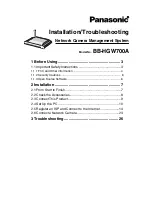
Section 2
Functional Description
11
FT205EV Wind Sensors
– User Manual
2.7 Error Detection
The sensor has a self-checking mechanism which can detect if a reading is invalid. On very rare occasions where
an invalid reading may have been detected, this is signalled to the computer or data logger by setting an error
flag character within the wind velocity output message (see Sections 6.4.29 and 6.4.30).
When an error is detected, the error flag character is set to a value of: 1.
Note: An optional Overspeed Warning Scheme can be enabled (but is disabled by default). See Section 2.8 for
further details.
It is important that error flags are not ignored. Data associated with an error flag should
not
be processed as valid
wind data. The system should be capable of riding through rare periods when data may be temporarily unavailable.
If errors are ongoing (more than several seconds), a reset of the sensor should be applied (see Section 6.4.20 for
instructions on sending an RSU command).
It is recommended that errors are monitored and logged. If the frequency of errors has recently increased, then
inspection of the sensor for physical blockages may be required (see Section 4.1).
2.8 Overspeed Warning Scheme
During periods where the sensor detects wind speed beyond the rating of the sensor, the sensor will (by default)
indicate a general error flag status.
An additional overspeed warning scheme can be enabled: if an overspeed condition is detected (above the highest
speed rating), the error flag character will be set to: 2 (see Sections 6.4.29 and 6.4.30) unless a general error
condition is also detected and the flag will be set to 1.
This scheme is disabled by default.
The Overspeed Warning Scheme can be enabled by software commands (see Section 6.4.19), via the Acu Vis
PC software program or enabled in the factory before despatch.
2.9 Acoustic Temperature
The Acoustic Temperature feature takes a measurement of the ambient temperature via measurable acoustic
properties of the airflow. Sections 6.4.2 to 6.4.4 describe related software commands.
Averaged data should be used. The averaging system can be performed for 0 to 50 seconds (in increments of 10
seconds), or between 1 to 10 minutes (in increments of 1 minute).
See Section 2.1 for details regarding operating specifications. Operation with high temperature gradients
(between sensor body and ambient airflow), extreme humidity levels and low wind conditions (below 5m/s) may
result in reduced accuracy.
Caution: The acoustic temperature feature requires calibration at FT Technologies. If the sensor has had a
software upgrade to 7.5 (or above) then the data will be uncalibrated and may not comply with the official
specification.












































